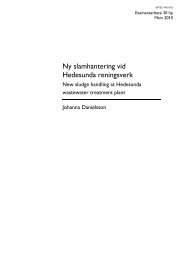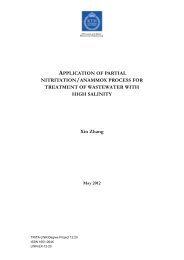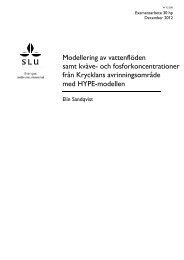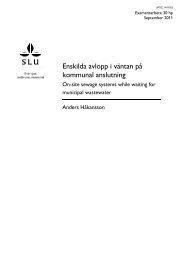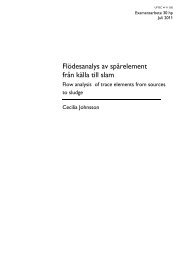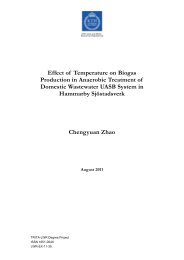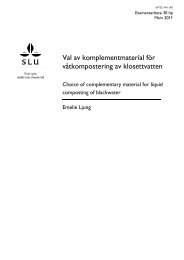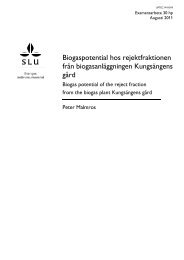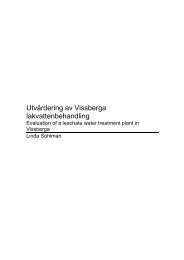Exergy saving and exergy production in municipal wastewater ...
Exergy saving and exergy production in municipal wastewater ...
Exergy saving and exergy production in municipal wastewater ...
Create successful ePaper yourself
Turn your PDF publications into a flip-book with our unique Google optimized e-Paper software.
<strong>Exergy</strong> <strong>sav<strong>in</strong>g</strong> <strong>and</strong> <strong>exergy</strong> <strong>production</strong> <strong>in</strong> <strong>municipal</strong> <strong>wastewater</strong> treatment<br />
Mediators <strong>in</strong> an oxidized state can easily be reduced by captur<strong>in</strong>g the<br />
electrons from with<strong>in</strong> the membrane. The mediators move across the<br />
membrane <strong>and</strong> release the electrons to the anode <strong>and</strong> become oxidized<br />
aga<strong>in</strong> <strong>in</strong> the bulk solution <strong>in</strong> the anodic chamber. This cyclic process<br />
accelerates electron transfer rate <strong>and</strong> thus <strong>in</strong>creases the power output.<br />
1.29. Suitable mediators<br />
Suitable mediators are able to cross the cell membrane <strong>and</strong> are able to<br />
grab electrons from the electron carriers of the electron transfer cha<strong>in</strong>.<br />
They possess a high electron reaction rate <strong>and</strong> additionally they solve<br />
well <strong>in</strong> the anolyte. They should be non-biodegradable <strong>and</strong> non-toxic to<br />
microbes <strong>and</strong> as cheap as possible. A mediator with the lowest redox<br />
would <strong>in</strong> theory give the lowest anodic redox <strong>and</strong> the maximum redox<br />
difference between anode <strong>and</strong> cathode. It would not necessarily be the<br />
most efficient at pull<strong>in</strong>g electrons away from the reduced <strong>in</strong>tracellular<br />
systems with<strong>in</strong> the microbes. The toxicity <strong>and</strong> <strong>in</strong>stability of synthetic<br />
mediators limit their applications <strong>in</strong> MFC. Some microbes can use<br />
naturally occurr<strong>in</strong>g compounds <strong>in</strong>clud<strong>in</strong>g microbial metabolites<br />
(endogenous mediators) as mediators. Mediatorless MFCs are<br />
advantageous <strong>in</strong> <strong>wastewater</strong> treatment <strong>and</strong> power generation because of<br />
high cost. For those microbes that do not readily release electrons to the<br />
anode, activation polarization is an energy barrier that can be overcome<br />
by add<strong>in</strong>g mediators.<br />
Culture: Us<strong>in</strong>g complex mixed culture allows much wider substrate<br />
utilization. It means that MFC have much wider substrate specificity<br />
when mixed than do pure culture.<br />
In the mixed culture MFCs with anaerobic sludge, there are electrophiles,<br />
anodophiles <strong>and</strong> groups that use natural mediators together <strong>in</strong> the same<br />
chamber ( Logan et al, 2006).<br />
1.30. Activation polarization<br />
This concept is an activation energy that must be overcome by react<strong>in</strong>g<br />
species. Adsorption of reactant species, transfer of electrons across the<br />
double layer cell membrane, desorption of product species <strong>and</strong> the<br />
physical nature of the electrode surface all contribute to the activation<br />
polarization. A good MFC should m<strong>in</strong>imize concentration polarization<br />
by enhanc<strong>in</strong>g mass transfer (Logan et al, 2006).<br />
1.31. Geobactersulfurreducens<br />
These bacteria are famous for its capability <strong>in</strong> reduc<strong>in</strong>g the metal ions<br />
like Fe 3+ <strong>and</strong> Mn 4+ considered as extra cellular electron acceptors.<br />
Geobactersulfurreducens can make biofilm on the anode <strong>and</strong> they are<br />
good <strong>in</strong> produc<strong>in</strong>g pilis or nanowires. These pilis are able to access the<br />
anode surface through the thick biofilm <strong>and</strong> transfer the electron directly<br />
to the anode. Pilis actually conduct electron through the biofilm.<br />
Electrons can also transfer to the anode by c-type cytochrom.<br />
Geobacter is low <strong>in</strong> c-type cytochrom. Selective pressure can be good <strong>in</strong><br />
highly regulated, complex physiological media <strong>in</strong> order to make a desired<br />
microorganism. Several studies have demonstrated that the current<br />
densities of complex microbial communities <strong>in</strong> microbial fuel cells can<br />
<strong>in</strong>crease over time or with serial transfer (Yi et al, 2009).<br />
1.32. Measur<strong>in</strong>g MFC efficiency<br />
The surface area of cathode relative to that of anode <strong>and</strong> the surface of<br />
the membrane affects the power produced by the cell. The larger the size<br />
of the electrodes, the larger the electricity produced.<br />
27



